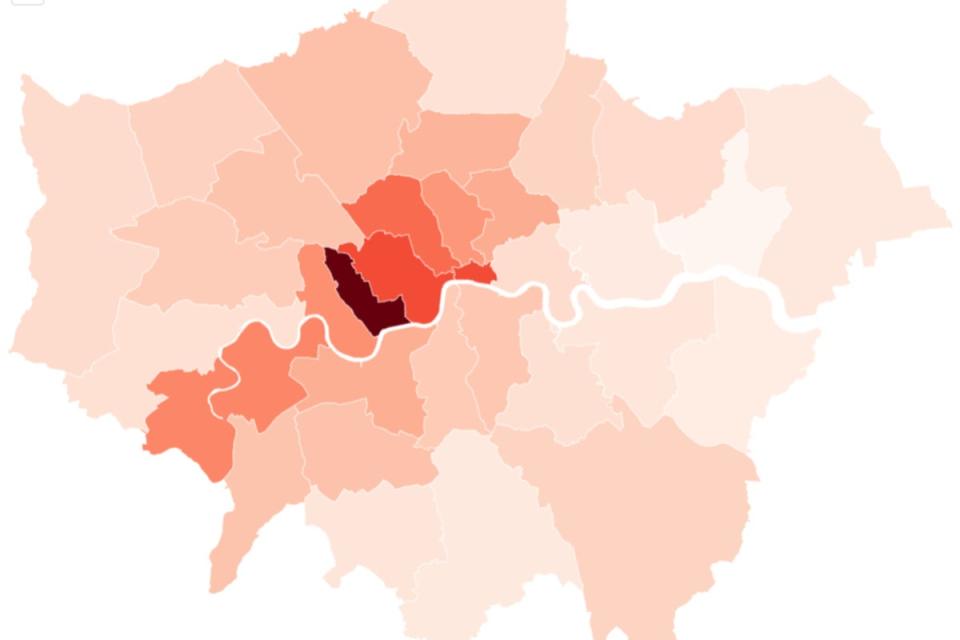London house prices: have they risen or fallen in your borough?

London has the slowest annual price growth of any region in England, with average sold prices increasing by 6.3 per cent in the year to November 2022, according to new figures from the Office of National Statistics (ONS).
However, with average sold prices now £542,300, the capital remains the most expensive UK region in which to buy a home.
Outer London boroughs saw the biggest house price rises in the year to November with Tower Hamlets, Brent, Hackney and Hillingdon all seeing annual growth of more than 11.5 per cent.
The exception to this is the City of London which saw growth of 18.5 per cent, and a new average price of £935,700, but the data is likely to have been skewed by the borough’s small area size of just over one square mile.
The biggest dips in annual growth were seen in the most expensive London areas, such as Kensington and Chelsea (-6.3 per cent) and the City of Westminster (-5.1 per cent).
Barking and Dagenham in east London remains London’s cheapest borough with average sold prices of £359,800, this is despite annual growth of 10.6 per cent.
Today’s figures are based on completed property transactions — and therefore the ‘sold’ prices — in the year to November 2022. This means the figures released today reflect the aftermath of the disastrous mini-Budget and the quiet period in the run up to Christmas.
Tom Bill, head of UK residential research at Knight Frank, said: “Mortgage rates are edging down as the shock of the mini-Budget works its way through the system but are still around 1.5 percentage points higher than last summer. A new normal is gradually emerging for rates and over the next few months we will get a clearer sense of how people react once they recalculate their budgets. This decision-making process rather than what happened last year will set the trajectory for the housing market in 2023.”
Jeremy Leaf, a north London estate agent, said: “On the ground, since our return to work nearly three weeks ago, we have noticed the release of some pent-up demand now mortgage rates have begun to fall.”
Jason Tebb, chief executive officer of property search website OnTheMarket.com, said: “Continuing upheaval, changes in the macro-economic climate and the chatter around mortgage rates, with fixes in particular much higher than borrowers have become accustomed to, are all bound to have affected the confidence of the average property-seeker.
“That said, while the market continues to rebalance, it is doing so in a reassuringly measured way rather than a drastic readjustment.”
Kensington & Chelsea remains the most expensive area to buy a home in England. Homes in the west London borough cost £1.3 million on average, more than 10 times the price of homes in Burnley, Lancashire, which is the cheapest area to buy a home in England.
Mark Harris, chief executive of mortgage broker SPF Private Clients, said: “Inflation dipping for the second month in a row to 10.5 per cent will help ease some pressure on the Bank of England but another increase in base rate next month is still on the cards.”
UK house prices
The average UK house price edged down in November from a previous record high, according to the ONS.
Property prices increased by 10.3 per cent in the year to November 2022, slowing from 12.4 per cent annual growth in October 2022.
The typical UK house price in November was £295,000, a £1,000 drop from the previous month’s record high of £296,000.
The average UK house price was £295,000 in November 2022 – down from £296,000 in October 2022.
This is £28,000 higher than the same period a year ago.
➡️ https://t.co/3Sf1tlDy4f pic.twitter.com/ks6SEwvFRu— Office for National Statistics (ONS) (@ONS) January 18, 2023
Average house prices increased over the year to £315,000 (a 10.9 per cent annual increase) in England, to £220,000 in Wales (10.7 per cent), to £191,000 in Scotland (5.5 per cent) and to £176,000 in Northern Ireland (10.7 per cent).
Nathan Emerson, Propertymark Chief Executive, said: “Estate agents in London are reporting buyers agreeing sales at under the asking price, however agents in the North West are seeing properties sell for asking price very quickly after being marketed, sometimes in a matter of days. Buyers are looking for more affordable properties, if sellers are realistic with their pricing, there are plenty of serious buyers out there that will move quickly.”
Within England, the North West was the region with the highest annual house price inflation in November — an increase of 13.5 per cent.